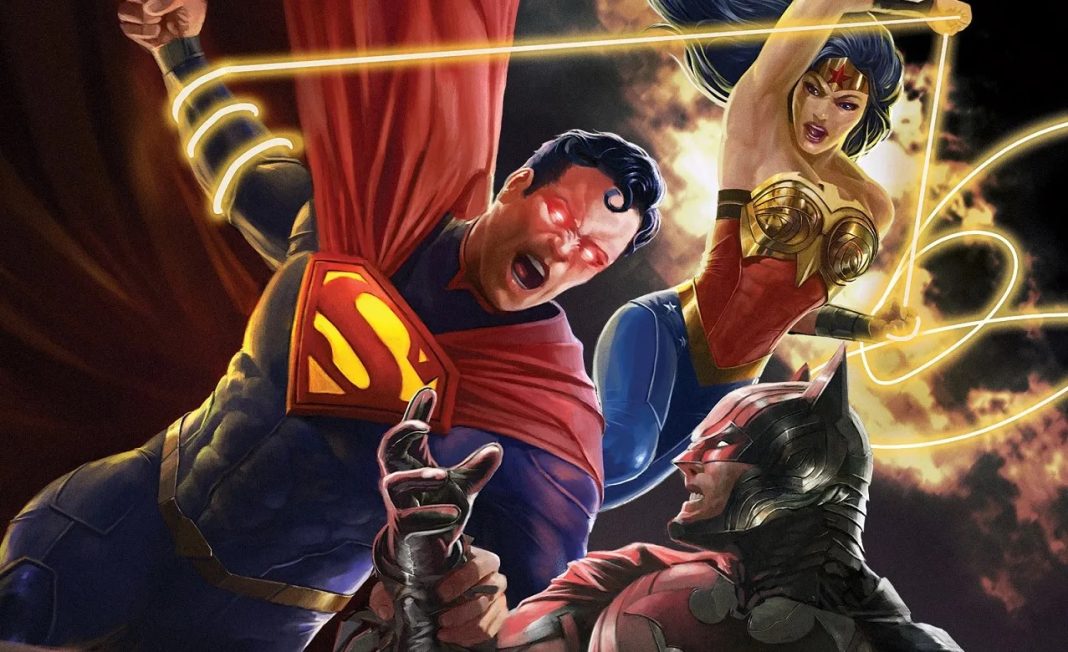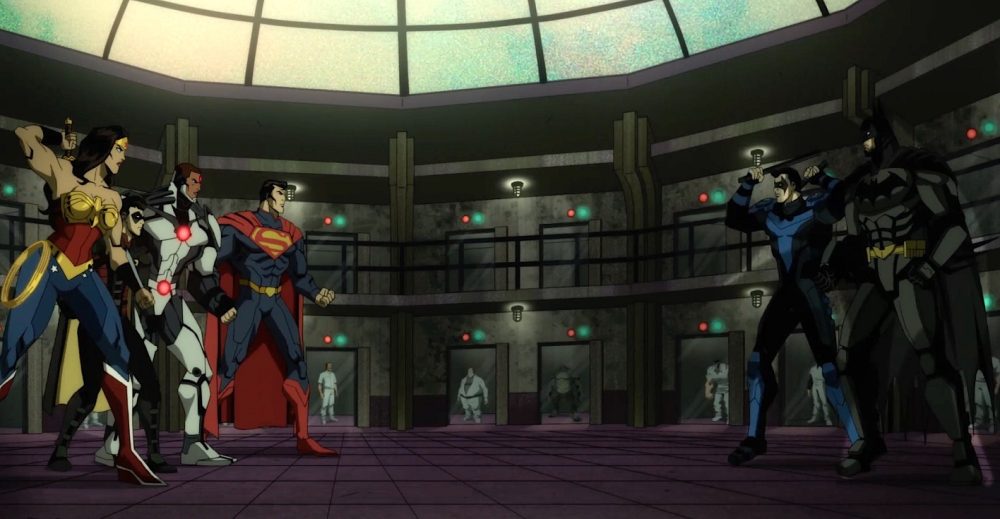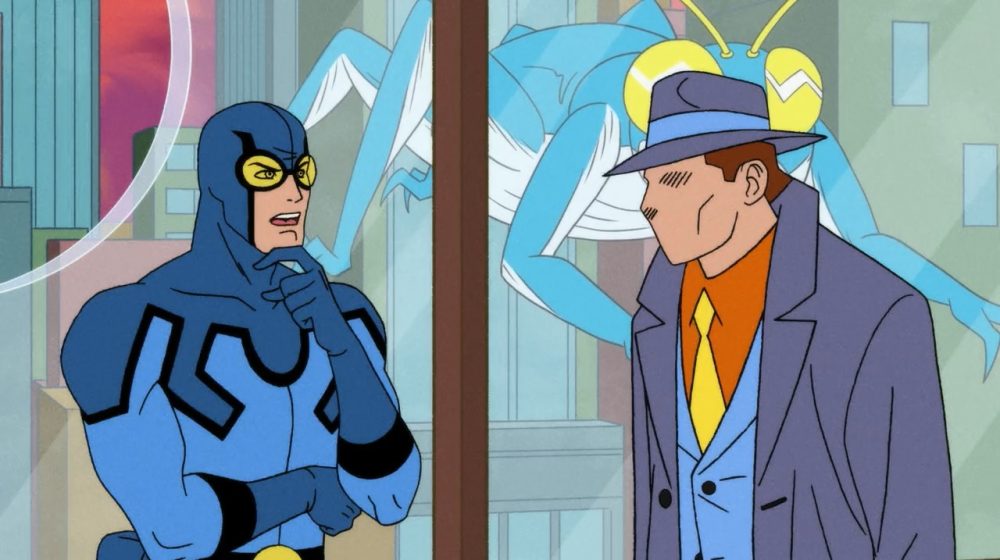Nearly a decade ago Injustice: Gods Among Us video games were introduced to a new version of the DC Universe where Superman gave in to his darker impulses after an unthinkable tragedy occurred on his watch. The game was a massive hit and spawned an acclaimed and tie-in comics series, Injustice: Gods Among Us: Year One. You can only imagine the challenge faced by the filmmakers of the new Injustice film in adapting the franchise to animation. The Beat had to chance to speak with some of the filmmakers behind the latest DC animated project.
For the last few years Rick Morales has primarily worked on Warner Bros. Animation projects geared towards younger audiences such as the LEGO DC series of films. However, he clearly showed his aptitude for adult action fare with the recent Mortal Kombat Legends animated films. The Injustice game like Mortal Kombat was produced by NeatherRealm Studios, and as a lifelong fan and gamer, there was perhaps no one better suited than Morales. Ahead of the release of Injustice, The Beat had a chance to chat with Morales adapting the franchise for animation as well as the amazing Blue Beetle DC Showcase short.
Taimur Dar: When I interviewed you for Mortal Kombat Legends: Battle of the Realms you revealed that you’re a video game player. In fact, you joked that you probably played the Mortal Kombat games more than you should. So I’m curious if you also played the Injustice game which came out almost a decade ago.
Rick Morales: Jesus, it was 10 years ago! I did play the games a fair bit. Not so much the second one but mostly the first one. I do own both and I have gotten into them. Also the mobile game.
Dar: I’ve just started reading the Injustice tie-in comics that Tom Taylor wrote. I know it’s easy to dismiss comic tie-in material, but I’ve heard people say how phenomenal the Injustice comics are for years. Were you familiar with the comic book tie-in material and what were your thoughts on them?
Morales: I’ve gotta be honest with you. Generally speaking, those sort of tie-in things aren’t great. But this is a case that is so different. I think the books expand the Injustice universe in such a great way. I started reading the Injustice comic books a few years ago. I burned through the first 15 issues on an airplane thinking, “I’ll check this out. Whatever.” [Laughs]. And then I couldn’t put it down. It was a great launching pad for this. But the guy that gets the most credit here for me is Ernie Altbacker, our writer, because he really went through and studied that stuff and had to find a way to distill it down into one manageable film. I think he just did a wonderful job with that.
Dar: Obviously, fans have latched onto this franchise. The idea of Superman going rogue and establishing a totalitarian regime isn’t exactly a new concept. We’ve seen it before like in the Justice League cartoon or the Superman: Red Son comic and animated adaptation. What do you think it is about Injustice that has resonated with fans and made it such a success?
Morales: It’s just a cool twist on the characters. Visually those games look fantastic. For me, this story sets it apart from the others in that it’s an exploration of Superman’s journey into becoming that thing, into becoming the bad guy. The most important thing that I was reaching for in this film was to show that Superman is doing these things for arguably good reasons. Or at least there would be some sense in the world that he should do this. He’s going to disarm these people and take down this horrible regime down there and do it unilaterally. He’s going to kill the Joker? Finally! I think that would be the reaction of a large amount of people in the real world. I think there’s an argument up until a certain point that Superman is not a bad guy. He certainly doesn’t think he is. But I do like that he’s questioning himself.
I wanted to make a point of being true what I think Superman’s thought process would be [and] his spirit and the Superman that we all know and love. It’s such a horrible thing that happens to him in the first 10-12 minutes of this film. It’s going to damage you. And how is that going to change your outlook on the world going forward? He loses his wife, his unborn child, his city. He’s failed in every regard. He’s the protector of Metropolis and he didn’t do it. I wanted to show how that process could happen. And at the same time not have you thinking, “Oh, Superman is a villain!” There are shades to his villainy.
Dar: As dark as the film gets, you manage to feature some much needed lighthearted and humorous moments. The comedy comes through Harley Quinn not surprisingly but also in other places I wasn’t expecting like Damian’s insult towards Calendar Man. How do you maintain that serious tone but also inject humor into the film?
Morales: So much of that great stuff is from the comics themselves. One of my favorite things from the books is the relationship between Green Arrow and Harley which seems an odd pairing but does provide some lightness. I never want these movies to be these dark slog fests where everything is dreadful and there’s no light at the end of the tunnel. This movie could get really dark and it does get really dark. Because of that, as a balance, you need to take some of the air out every now and again and let a Harley Quinn let you laugh. Or let a Plastic Man have a silly moment. Otherwise, it’s just all dread and dark and I’m not interested in doing that.
Dar: Speaking of balance, the Injustice film features a huge cast of characters. I know ensemble films are much more challenging than solo character stories. Viewers who aren’t comic book readers can easily get confused so can you speak to dealing with a large cast of characters as a filmmaker?
Morales: There is a huge cast and a bunch of characters who play a huge role here. At its core, it’s a Superman and Batman film. You’re right. I think as a filmmaker and producer we don’t have time in this film to show you the board from [the perspective] of Superman, Batman, Wonder Woman, Robin, or Cyborg. [Laughs]. There are so many characters in here that you have to go along for the ride. I always approached it knowing that there may be people who don’t know who Mister Terrific is and his entire history. But I honestly don’t find that important. I assume at this point, and it’s a good assumption, that everybody is familiar with Superman and Batman in some fashion. Since those are our anchors for our film, I think it’s not confusing to have someone like Mister Terrific. Maybe you don’t know who he is but you understand the role he’s playing in this film. He’s another superhero who’s discouraging Superman from the actions that he’s taking. You don’t need to know too much more than that and if he piques your interest, there’s a bunch of stuff out there that you can check out. I’m hopeful that this sort of thing will do.
When I was a kid and I picked up my first comic book, I knew who the main character was but I didn’t know any of the ancillary characters. I didn’t know what storyline I was getting into. I picked it up and kept going. And then I wanted to look back and find out who that was. I’m thinking about it from that perspective. Hopefully, if people are coming into this a little bit cold, it will be interesting enough for them to look at the rest of the world. God knows that comics could use more readers.
Dar: Much like Mortal Kombat Legends: Battle of the Realms, the Injustice film definitely has a sense of closure but leaves the door open just enough so you could possibly return for a sequel. Was Injustice intended as a single film or is there a possibility to return to this continuity?
Morales: [Laughs] This was definitely planned as one film but I never want to close any doors. We only ever thought about this as one film. It’s based on comic books. They’re serialized. You can always tell more stories.
Dar: Finally, I gotta inquire about the phenomenal DC Showcase Blue Beetle animated short, which is a giant love letter to that classic 1967 Spider-Man animated series. What was the experience of making that delightful short?
Morales: That was so much fun! I’m so happy you asked about that! We just got to cut loose. Every mistake in that short was planned. We had to miscolor Blue Beetle and make sure he was off-model for certain scenes. It was all very intentional and just a lot of fun to do something that was such an homage to stuff that we loved.
Matt Peters directed perhaps the most involved project of his animation career when Justice League Dark: Apokolips War, which served as the swan song for the previous DC animated shared universe, was released last year. You’d assume after such a massive undertaking Peters would follow up with a less expansive, but instead, Peters opted to helm Injustice and The Beat chatted with Peters about another large ensemble film, the fantastic DC Showcase Kamandi short, and much more.
Taimur Dar: Having spoken with producer Rick Morales and screenwriter Ernie Altbacker, Morales revealed he was familiar with Injustice and had played the video game while Altbacker went into it with no prior knowledge? Where do you fall compared to them?
Matt Peters: I was very much like Ernie. I had heard of the game and I had heard of the comic. But I had not played or read either. It wasn’t until Rick told me about this that I did a little investigation on both. It’s an incredible game. I’m not a game player but I wish I could play it more often! [Laughs]

Peters: I was lucky to work on both is how I feel. I love James Tucker. I love working with him. Apokolips War was a blast and working with Christina Sotta was also a blessing. She’s so unbelievably talented. Having somebody else help carry the load made it so much more manageable for me to be able to know I could so confidently rely on someone who knew what needed to be done. Hopefully, she felt the same way about me.
This was fun because if anything I think I was more greedy in this movie. Being a Superman fan I got to really indulge and I think I wouldn’t want to have shared directing credit on this movie because I love Superman so much. I would’ve been like, “Back off! This is mine!” [Laughs].
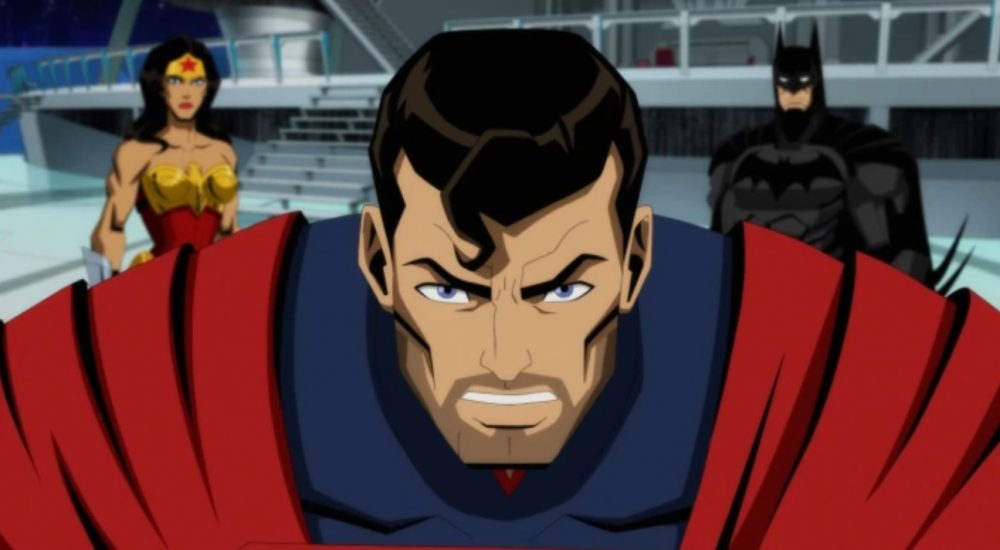
Peters: You’re hitting it on the head. It was definitely something we were working hard to do when it came to Superman’s conflict. Just like you’re saying, we saw it as Batman being the angel and Wonder Woman oddly being the devil. One of the things that I love about Injustice with the exception of Harley Quinn is that all our characters are heroes in conflict with one another. So you want to make sure that every heroic character had a heroic motivation for what they were doing. So you understood Superman’s point of view [or] Wonder Woman’s point of view even though you may not agree with them. And then you also got to see Batman also struggle himself. I like to point out that even though Batman has the moral high ground, the way he treats Damian is not all that fantastic. It makes for another bit of complication with these characters.
Dar: Whenever you have these large ensembles with superheroes in conflict with each other, it can be confusing for viewers to remember who is on whose side. Were there any challenges in that regard in order to convey clear storytelling?
Peters: Actually I think the most complicated thing in dealing with that was giving the right amount of motivation for each character. I can’t think of any character that’s in this that I’m not a fan of to some degree. I’m a huge Superman fan. I love Wonder Woman and Batman. You never want to sit and make the character you love so much be on the wrong side of the situation without giving them the right motivation. That was something we were always considering. I hope that it pays off and adds to that fan satisfaction. Even though characters may end up on the wrong side of a situation, you want to understand how they ended up on that side and you want to feel for them.
Dar: You worked on the Kamandi short for the current crop of DC Showcase animated shorts. I’ve always enjoyed the DC Showcase shorts but I definitely feel these latest ones knocked it out of the park. The Kamandi short really invoked the animation of the ‘70s when Jack Kirby created Kamandi and that whole Planet of the Apes vibe. I’d love to hear your experience working on it and creating that unique animation style.
Peters: Thank you. That means a lot to hear because that’s what Rick and I were really pushing on. I think a lot of the credit for that one should really go to Rick because he really wanted to push the designs and look and feel of that to craft a very Kirby universe and setting. For me, I read the comics when I was a kid and while reviewing the boards and doing any board work I would be listening to the soundtrack, and Planet of the Apes figured into the spirit of things. I think it’s really fantastic and I’m happy to hear that fans are feeling that it did Jack Kirby proud because that was something we really wanted to do. I know Rick set out to make it feel like the comic come to life. He managed to push those designs in such a great way that they resonate with fans as much as I hope it does.
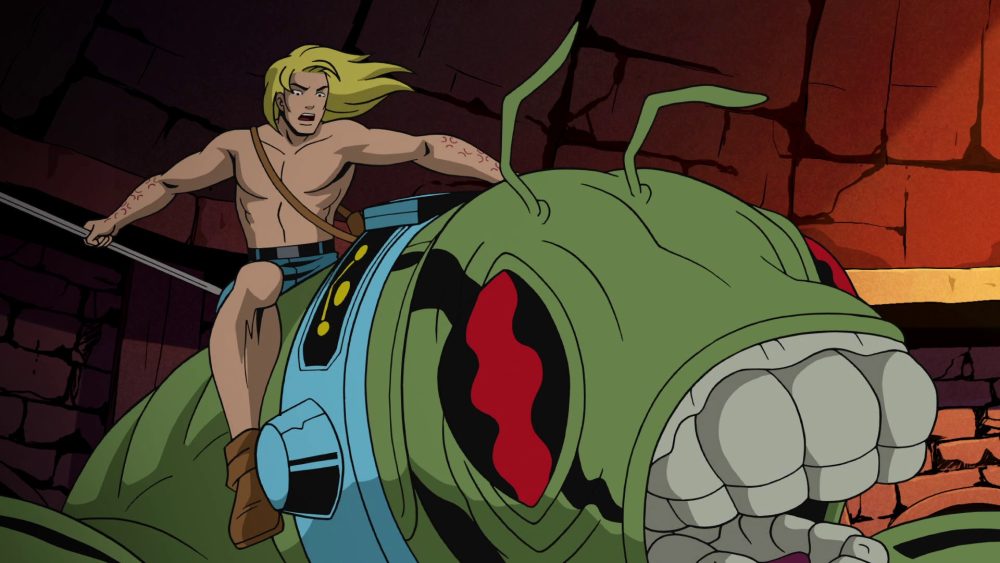
Peters: I hope this doesn’t sound like a cop-out but I love all of it. Other people have asked me if it’s weird to shift gears to go from comedy to action. The truth of the matter is that it isn’t. From my point of view, I love these characters. I really love bringing out whatever aspect of the characters I get to exploit. If it’s comedy I enjoy it because I get to play those characters in a more child-friendly way that makes me feel like I’m reliving my childhood. And if I work on something darker or more mature, it’s me as an adult getting to a chance to indulge in the deeper meaning of these characters that I like so much. Ultimately I end up winning because I get to work on characters that I love. I feel like that’s the best part of my job.
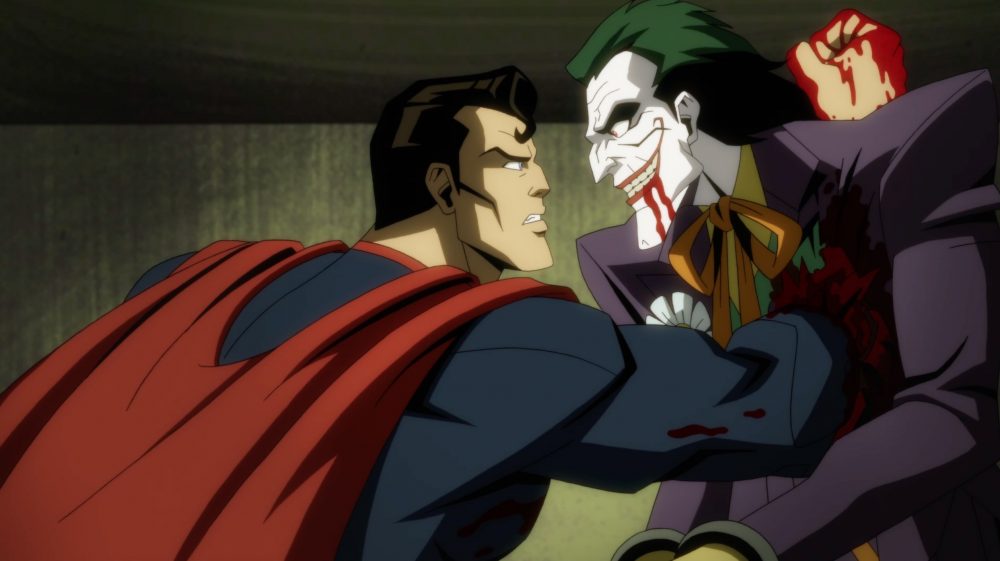
Peters: I always was trying to make sure I understood. The moment for me where he crosses the line where even I as a fan lost interest is when he comes across the young people who were fans of the Joker. That moment then, and I think Rick would agree, that was where we wanted to make it where there’s no turning back for this Superman. He does things that are kind of irredeemable at that point. We also didn’t focus that much, if you notice, on him as a character. We actually cut outside during that scene and that’s because at that point for myself, and I think for Rick as well, we became emotionally detached from him in terms of his actions.
Dar: I’ve definitely gotta rewatch it now to pay attention to that scene.
Injustice is available now on Digital, Blu-ray and 4K Ultra HD


